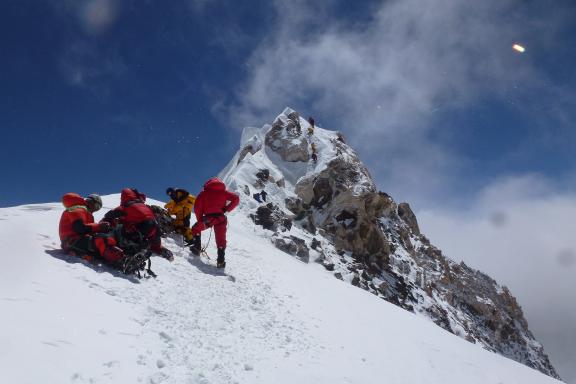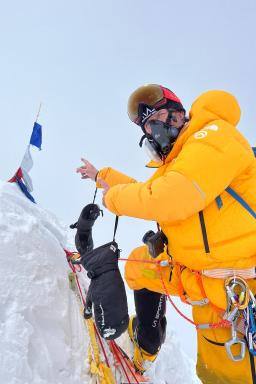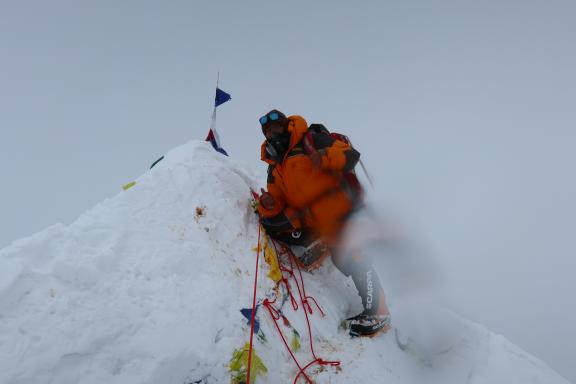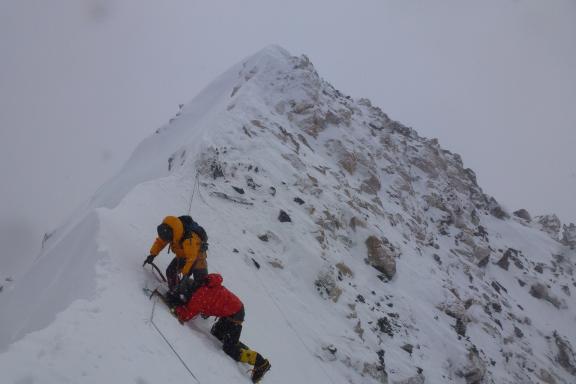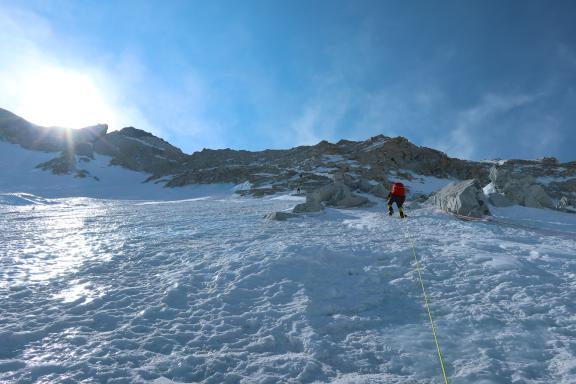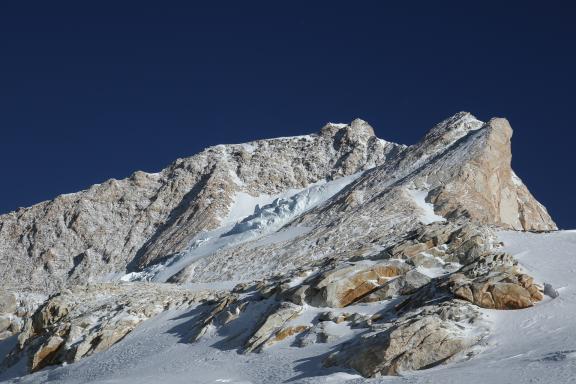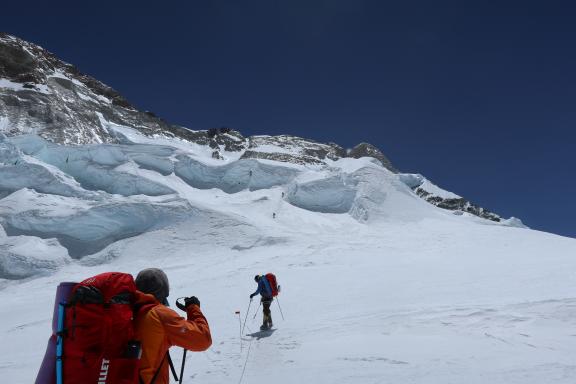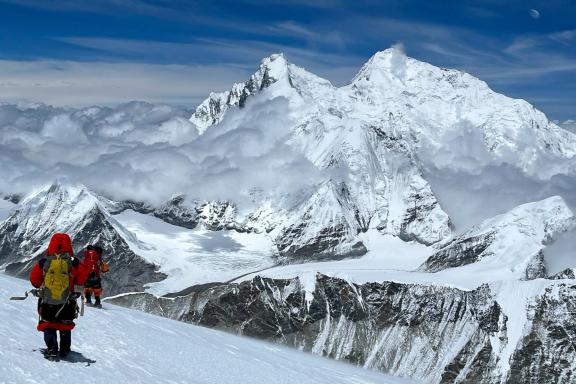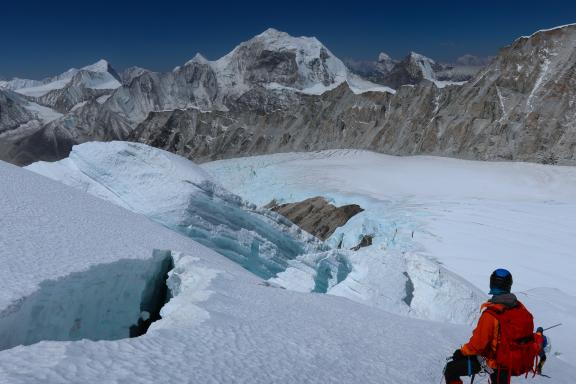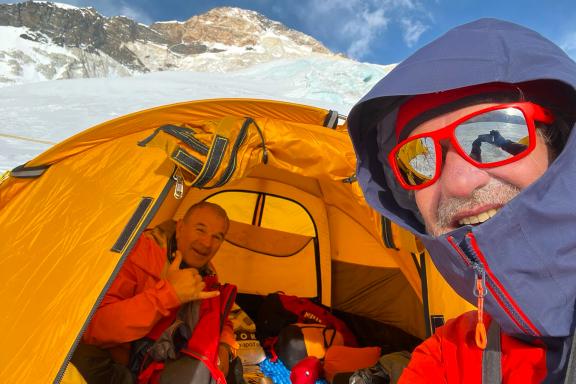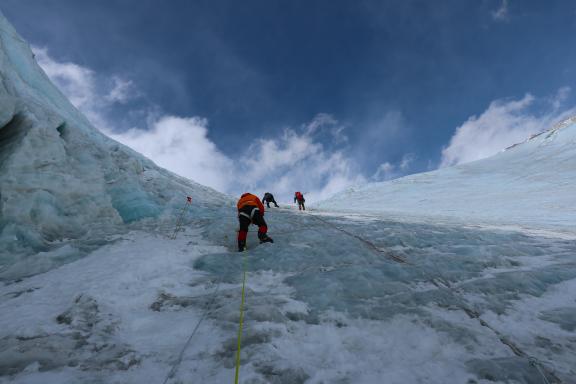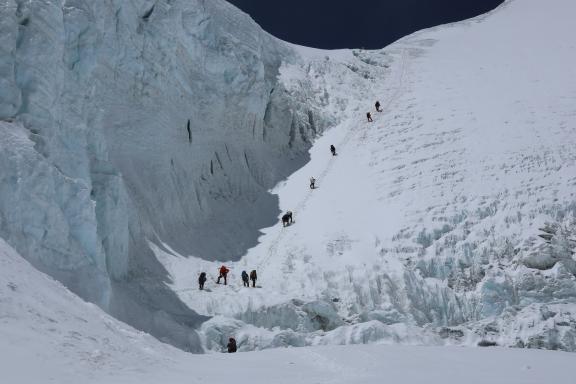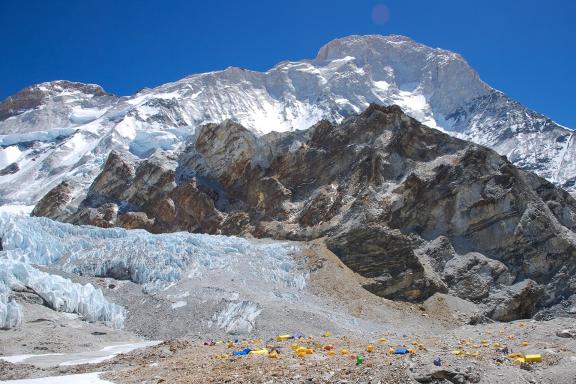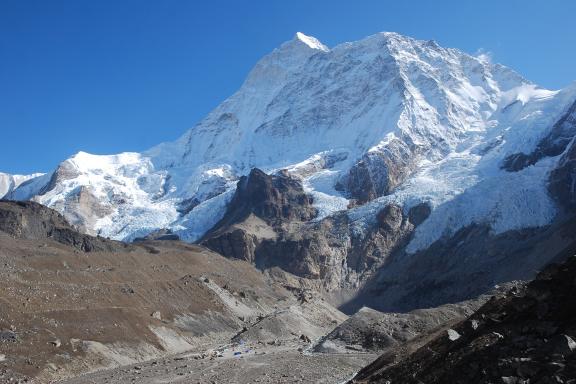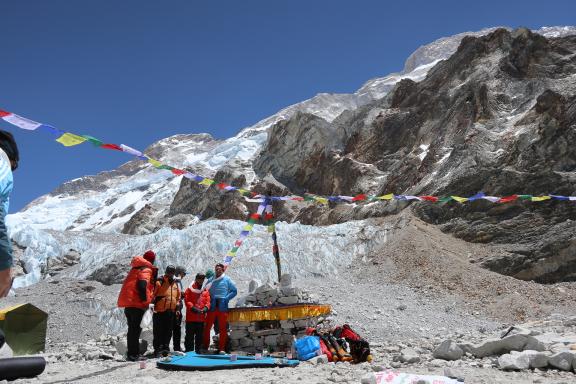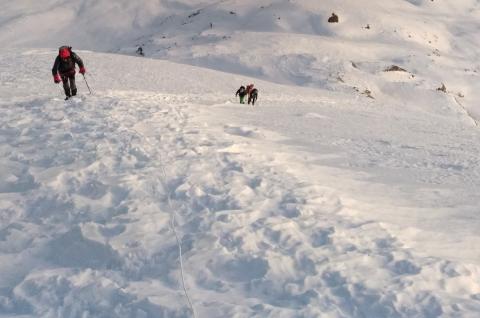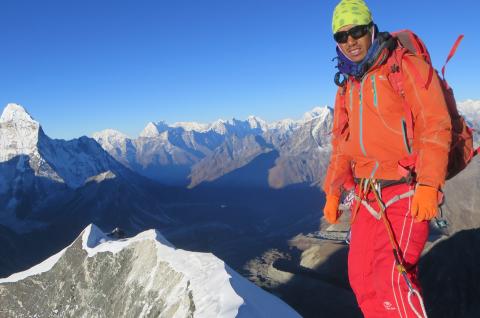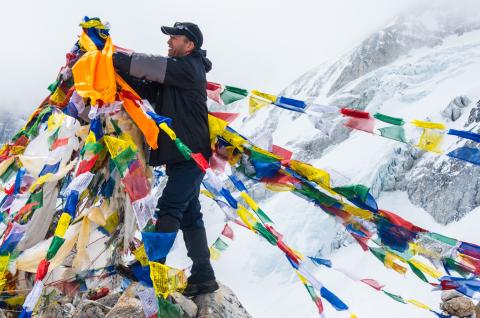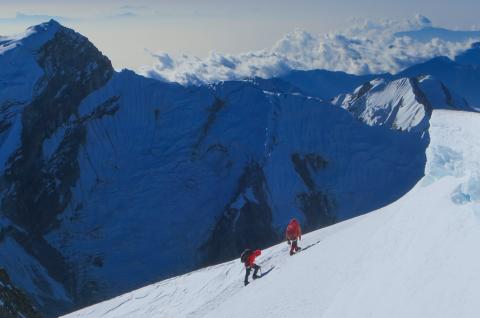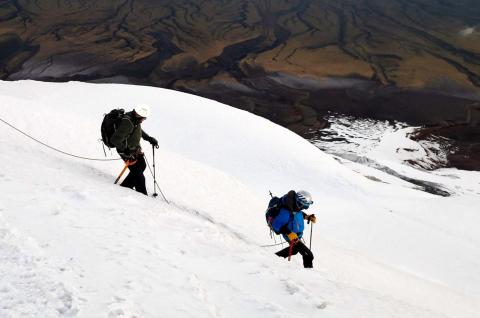Magnificent challenging 8000er with few objective hazards
Highlights
- Ratio of 1 sherpa to 1 participant
- Ascent with few objective risks
- Nice approach trek for acclimatization
- Experienced expedition leader
- Special care given to high-altitude food
- H24 personalized weather services and medical hotline
- Preparation course, live expedition coverage
- Guaranteed departure from the first participant
For this extraordinary adventure, the ascent of Makalu to 8485 meters, we are guided in a small group by a mountain guide highly experienced at high altitude. "Makalu, a magnificent pyramid isolated in a wild region", sums up guide Lionel Terray, the most famous participant in the victorious French expedition to Makalu in 1955. Today, the approach is an 11-day trek via the Shipton's trail. Then comes the ascent itself, which takes four camps. The main difficulty of the route lies between Camp 2 (6600 m) and Camp 3 (7500 m), with a long spur in mixed terrain, with no possibility of setting up an intermediate camp, requiring excellent physical condition and the ability to abseil. A major summit for experienced mountaineers only.
Overview
We propose an expedition to the summit of Makalu, at 8485 meters above sea level, on the border between Tibet and Nepal in the Himalayas. It is the fifth highest peak in the world.
"Makalu, a magnificent pyramid isolated in a wild region". So summed up guide Lionel Terray, the most famous participant in the victorious French expedition of 1955. The first expedition over 8000 meters where every member of the group, including the Sirdar, reached the summit. A remarkable feat for its time.
Today, the approach is an 11-day trek via Shipton's trail, named in honor of the great British explorer and mountaineer who, along with Edmund Hillary, first explored access to Makalu by crossing from the foot of Everest.
Then comes the ascent itself, carried out in four camps. The main difficulty lies between Camps 2 (6600 m) and 3 (7500 m). A long spur in mixed terrain, with no possibility of establishing an intermediate camp, requires excellent physical condition and the ability to abseil (placing and removing one's descender independently).
This is a far cry from the cohorts that climb the slopes of Cho Oyu, or even Everest. A major summit reserved for experienced mountaineers.
Read our blog entry on Makalu (8465 m), a happy page in Himalayan history.
To ensure a trip in the best possible conditions, we concentrate our resources, strength and expertise on small teams. One of the most renowned French mountain guides accompanies you throughout your expedition. He is supported by an experienced local team of sherpas. An altitude sherpa accompanies you throughout the ascent.
The approach hike via Shipton's trail to reach base camp provides essential time for acclimatization. A few days spent at base camp complete the acclimatization process.
Our team is made up of cooks and high-altitude sherpas with whom we work regularly. All of them are experienced and qualified, and hold government approvals. In addition to their efficiency and hard work, they have excellent people skills. We provide them with quality clothing and equipment, and insure them in accordance with Nepalese government regulations.
Our base camp is designed to be as comfortable as possible, with personal tents for participants, showers and toilets, a mess tent, and so on.
To find out more about the history of the Makalu ascent, read our blog post "Makalu (8485 m): a happy page in Himalayan history"."Makalu (8485 m): a happy page in Himalayan history".
Click here to see the animated itinerary for the ascent of Makalu to 8485 meters.
MOUNTAINEERS' WORDS
These words from the mountaineers who climbed Everest apply perfectly to our ascent of Makalu.
"What is it that makes this summit so fascinating to all mountaineers?... It is the highest mountain in the world... The many expeditions, the men who have conquered it, have not succeeded in making it smaller... The altitude remains." – Reinhold Messner
"We didn't have to wait for the ultimate vision. Above the fog, Everest was still before us...: motionless as Keats's star in its solitary splendor, and so high in the night! Eternal watchman of the shadows, the Mount seemed to inebriate the world with its radiance." - George Leigh Mallory
"Suddenly, it occurred to me that the ridge in front of us, instead of continuing to rise, was falling sharply; much lower down, I could see the North Col and the Rongbuck Glacier; in the foreground, a narrow snow ridge climbed towards a snowy summit; a few more ice axe strokes in the hardened snow... and we were at the summit. It was 11:30 a.m." - Edmund Hillary May 29, 1953
COLLECTIVE ADVENTURE
Our expedition will be a collective adventure, a crossroads of motivations and energies, a meeting of the capacities of an organization and motivated mountaineers. Two parallel challenges will have to be met:
- for the participant: to be at the top of his physical, technical and mental level when need be;
- for the organizer: to provide impeccable logistics enabling access to the high altitude camps under optimum conditions. Beyond that, it is up to the participants to make their own way up the summit ridge.
The main objective of this expedition is to experience an adventure that requires total commitment, both physical and moral, acting with lucidity and humility in a hostile natural environment that forgives no imprudence or temerity at the risk of death. It is this testimony that must be wisely recounted.
Good observance of all safety rules is essential, as is good physical and psychological preparation, a warm and supportive environment, total serenity, a little tactics and then, if the weather is kind and luck is on our side, we will be able to count down the magic minutes at the summit when effort ceases and nothingness fills the space and instills itself within us.
OUR MOTTO IS: DARE TO CLIMB, KNOW HOW TO DESCEND
VERY HIGH ALTITUDE
Advice from Hubert Giot, mountain guide. He has taken part in several expeditions to 8000 meters and climbed Everest without oxygen.
It is not easy to establish rules, because mountaineers are not equal when it comes to altitude, either physiologically or mentally. Everyone seems to have their own plateau where they get stuck. Extremely tiring, this stage is always painful, but not prohibitive. Once you are past this stage, everything is fine... or not so bad. It is generally at this point that you get a better idea of your ability to adapt. This can happen as early as 6000 meters, or even earlier, during the approach trek.
High altitude also has its own rules, and transgressing them becomes inherently dangerous. There is a fundamental difference between climbing to 8000 meters and descending immediately, and staying there for 12 or 24 hours.
At this altitude, the trouble really starts, and every minute spent up there brings with it an inexorable process of self-destruction. We experience loss of sleep, lack of appetite, apathy and often hallucinatory phenomena.
In short... above 8000 meters, you are consumed. For novices, anything is possible, just remember a few basic rules. The first few days at base camp serve as a thermometer, and by the end of the third day you are often starting to feel good. It is then up to you to decide how to divide up the stages: you can either use the usual camp sites, or those defined by the terrain. As a general rule, when you can sleep at 6500 meters without headaches, you are ready to go higher. However, it is a good idea to make return trips to 7000 or 7500 meters, to test your potential. During these essential phases, it is important to stay well hydrated. Now it is time to spend an often uncomfortable night at around 7500 meters, then attempt the summit at 8000 meters. If the summit is beyond that, we try to sleep at 8000.
As for the rest, you need to be prepared to use your brain (or what is left of it) rather than your muscles, because meters, beyond 8500 meters, are expensive. And if I say brain, it is because it needs to be sufficiently alert to decide when to descend. If it does not, it is certain death. Doing an 8000er in good conditions is tough, but with cold, wind, snow or a barometric depression, it turns into a nightmare.
As a general rule, there are a few precautions to take:
- don't get too cold;
- don't get too hot;
- cover your head;
- stay hydrated, even in bad weather;
- try to have one hot snack a day;
- during the trek, do not walk bare-chested;
- at high altitudes, keep an eye on each other; don't doze off together;
- never descend alone;
- set limits for yourself, and look out for signs such as mirages, falling asleep and total loss of appetite;
- never hesitate to turn back, whatever the pressure;
- and in all cases, accept the fact that the mountains will always be there.
In short, to evolve at high altitude, you need meticulous preparation, adequate acclimatization, constant and mutual verification, intellectual vigilance at all times, and immediate renunciation in the event of weakness, doubt or danger.
Itinerary
Day 0
EXPEDITION SUMMARY PROGRAM
- Days 1 & 2: International flights to Kathmandu
- Days 3 & 4: Kathmandu, consular formalities and obtaining climbing permit
- Day 5: Flight Kathmandu — Tumlingtar, transfer to Num (1490 m)
- Day 6: Trek Num — Seduwa (1600 m)
- Day 8: Trek Tashi Gaon — Kongma Kharka (3470 m)
- Day 9: Trek Kongma Kharka - Mumbuk - Dobato via Shipton pass (3800 m)
- Day 10: Trek Dobato — Yangle Kharka (3650 m)
- Day 11: Rest and acclimatization day at Yangle Kharka
- Day 12: Trek Yangle Kharka — Barun Glacier (4300 m)
- Day 13: Trek Barun Glacier — Hillary Base Camp Makalu (4870 m)
- Day 14: Short acclimatization hike above Hillary camp
- Day 15: Rest at Hillary Camp or climb to Makalu Base Camp
- Day 16: Makalu base camp: acclimatization day
- Days 17 to 42: Ascent of Makalu (21 days)
- Day 43: Trek from Makalu base camp to Merek (4100 m)
- Day 44: Trek Merek — Yangle Kharka - Mumbuk - Dobato via Shipton pass (3800 m)
- Day 45: Trek Dobato — Sadema (2135 m)
- Day 46: Trek Sadema — Num (1490 m)
- Day 47: Transfer Num — Tumlingtar
- Day 48: Flight Tumlingtar — Kathmandu
- Day 49: Kathmandu
- Days 50 & 51: International flights
EXPEDITION DETAILED PROGRAM
Day 1: International flight
Day 1
Flight from Europe to Kathmandu. Arrival is usually on Day 2.
Day 2: Arrival in Kathmandu
Day 2
Arrival of all participants. Our team welcomes you and organizes your transfer to the hotel. Passports are collected to finalize the climbing permit application.
Days 3 & 4: Days in Kathmandu
Day 3
Check with the expedition leader on the equipment you are taking with you. If necessary, Thamel's many mountain gear stores can help you complete your equipment. In the meantime, our local team will take care of the essential administrative formalities and the necessary climbing permits.
Day 5: Flight Kathmandu–Tumlingtar — Road transfer to Num
Day 5
We leave Kathmandu in the morning for a superb one-hour flight to Tumlingtar along Nepal's Himalayan range: Langtang, Rolwaling, Khumbu in the distance. On arrival, our vehicle is waiting to take us to Num, a village perched high above the Arun River, the starting point of the trek.
Day 6: Num — Arun — Seduwa trek
Day 6
The trail continues for a few kilometers and plunges into the tumultuous Arun. We leave our vehicles and continue on foot with our porters. We cross over a suspension bridge and make the long ascent to the village of Seduwa, with its characteristic low-valley habitat.
Day 7: Seduwa — Tashi Gaon — Sadema trek
Day 7
The path continues to rise above the valley, but this time more or less following the contour lines, through a dense forest of bamboo, then birch and rhododendron. We pass the last village in the Arun valley, Tashi Gaon. Beyond this, the path twists and turns to reach the Sadema mountain pasture.
Day 8: Sadema — Kongma Kharka trek
Day 8
A steady but long climb. The forest clears out and we start to really enjoy the high mountain scenery around us. The rhododendron forest, depending on the year, may still be in bloom.
Day 9: Kongma Kharka — Shipton La (4127 m) — Keke La — Mumbuk — Dobato trek
Day 9
One of the most beautiful days of the trek, with the crossing of Shipton La (4217 m) amidst rhododendrons. At the start of the stage, we climb a grassy ridge with unobstructed views of Chamlang and Makalu. The path follows the ridge and climbs a series of steps. First pass, the Ghungru La (4050 m) before descending to a small lake (3850 m). Finally, a rocky couloir leads to the Shipton La (4217 m). Descent to two further lakes (4020 m), further ascent to cross the Keke La (4180 m). On the opposite side of the pass, a pleasant descent to the Mumbuk alpine pasture and further on to Dobato.
Day 10: Dobato — Yangle Kharka trek
Day 10
The path, clinging to the steep slopes of the Arun river basin, becomes more uncomfortable as it is less frequented. Only a few shepherds venture out here. We continue through primary forest before tackling the "Nepalese flat" (alternating ascents and descents...) on a track constantly swept by landslides. A word of advice: don't dawdle! We have lunch at the Phemathang kharka before crossing the river on a new wooden bridge, the last having been swept away by a gigantic mudslide in the spring of 2017. A new trail has been hastily laid out on the left bank of the Barun Khola, but it still needs some work. That said, it is still of much better quality than the morning's... We reach Yangle Kharka, a "village" made up of a few wooden houses.
Day 11: Rest and acclimatization day at Yangle Kharka
Day 11
Essential rest for our bodies to acclimatize to the altitude.
Day 12: Yangle Kharka — Barun Glacier — Langmale Kharka trek
Day 12
The first part of the day is spent on the left bank of the river, on a temporary path cut into the pebble bed. The traces of a mudslide are impressive, considering the tens of tons of boulders in the middle of the river... After an hour's walk, we return to the historic trail and continue through a pine forest. Through the branches, we enjoy splendid views of the glacial combes of Peaks VI and VII. It is a gradual climb to the Merek camp, where we can make out the blue-roofed Langmale lodge perched on the grassy moraine that closes off this part of the valley. But before we get there, we have to cross the "new" riverbed created by the mudflow, an indescribable jumble of piled-up rocks in the middle of which the sherpas have marked out a route. Beyond that, all that remains is to climb the grassy moraine to reach the Langmale sheepfolds and 20 minutes further on to the lodge. Superb views of Chamlang (7320 m), Peak IV (6720 m), Peak III (6477 m) and Peak V (6404 m).
Day13: Barun Glacier — Makalu Hillary Base Camp trek
Day 13
After crossing the Langmale alpine pastures, we reach the moraine on the left bank of the West Barun Glacier valley. We continue without too much effort to Shershong, where we turn right towards a well-marked pass in the middle of the moraine. At 4900 meters, we discover the imposing mass of the Himalayan giant, the master of the place, Makalu and its immense south face. It is truly enormous! We continue around a contour on a moraine-side path, while in the mineral combe below we discover the base camp lodges. A short descent to cross the river and we are snug and warm in the common room next to the lodge. It goes without saying that the views are exceptional and unforgettable... In the afternoon, we can make our way in 15 minutes to the moraine lake right next to the lodge, and even get a little height at the top of a pebble mound on which a labtse has been erected, planted with colorful Buddhist flags, the darchoks.
Days 14 & 15: Hillary Base Camp Makalu — Acclimatization days
Day 14
Day 16: Ascent to the real Makalu Base Camp or Advanced Base Camp
Day 16
Progress along the moraines following a line of cairns, first on a good path on the right bank of the Barun Glacier, then on a long traverse up the black glacier. We pass the foot of Makalu's impressive West Pillar, witness to the exploits of the team led by Robert Paragot in 1971. We cross the glacier to climb the scree slopes towards the north-west combe. And we reach the real base camp, or Advanced Base Camp, from which all expeditions depart.
Days 17 to 42: Ascent of Makalu (8485 m)
Day 17 to 42
We devote 21 days to the ascent of Makalu, the main stages of which are as follows:
From advanced base camp (5690 m) to Camp 1 (6165 m): 6 hours
Ascent of the northwest combe. This camp is used for one night only, to allow time for acclimatization. No particular difficulty.
Camp 1 (6165 m) to Camp 2 (6600 m): 3 to 4 hours
The route becomes steeper. A long ascending slope from right to left, requiring the crossing of a crevasse zone interspersed with a few 45° walls, approaches the base of the mixed couloir leading to Makalu La. A few short fixed ropes will be installed for the most delicate passages.
Camp 2 (6600 m) to Camp 3 (7500 m): 8 to 9 hours
Key section of the AD+ route. Slope between 50 and 55°, interspersed with passages of good rock. Route fully equipped with fixed ropes by our team of sherpas. Numerous abseils on descent. Camp 3 at 7500 meters lies just beyond the Makalu La, on the way to the north face. It is necessary to spend at least one night at Camp 3 to acclimatize, then descend to the advanced base camp for a rest.
Camp 3 (7500 m) to Camp 4 (7750 m): 4 to 5 hours
Long ascent traverse to the right. A few ice passages require the use of fixed ropes, but the gradient does not exceed 30-35°. Camp 4 will be used only once, the night before the summit attempt. It is located slightly below and away from the last serac zone.
Makalu summit: 8485 meters
Once participants have acclimatized, we climb directly from the advanced base camp to Camp 2 at 6600 meters, before heading off to Camp 3 (overnight), Camp 4 for a few hours' rest before the final ascent, and then back to Camp 3 (overnight).
Generally, departure for the summit is around midnight. 150 to 200 meters above the camp, you have to navigate between the last seracs. A long, easy but crevassed upward traverse (roping in required) to the left leads to the foot of the last couloir, the "French gully", equipped with fixed ropes and giving access to the ridge. Allow an hour to negotiate this spur and another 45 minutes on the thin ridge leading to the summit. The time required varies according to the wind and the fitness of the participants. The last few meters before the summit, on a very tapered ridge, are also equipped with fixed ropes. The summit is not suitable for several people. Between the ascent to the top of Camp 4 and return to Camp 3: from 7750 meters to 8485 meters and descent to 7500 meters, allow 11 to 12 hours.
Day 43: Makalu Hillary base camp — Merek trek
Day 43
We take the same route as before, but the stages are slightly different, as we are trained and the return to a lower altitude gives us wings!
DAY 44: Merek — Mumbuk — Dobato trek
Day 44
Day 45: Dobato — Sadema trek
Day 45
Day 46: Sadema — Num trek
Day 46
Day 47: Num — Tumlingtar transfer
Day 47
Day 48: Return flight from Tumlingtar to Kathmandu
Day 48
We take our one-hour flight to Kathmandu.
Day 49: Free day in Kathmandu
Day 49
Contingency day, free and unguided.
Day 50: International flight home from Kathmandu
Day 50
Depending on your flight schedule, you are accompanied to the airport to catch your return flight to Europe.
DAY 51: Arrival in Europe
Day 51
END OF EXPEDITION
For reasons that cannot be foreseen at this stage, such as unpredictable weather, the physical fitness or lack of fitness of participants or other circumstancess (customs formalities, road conditions, traffic, landslides, force majeure, etc.), your expedition leader may have to adapt the program, if necessary, to ensure the smooth running of your trip. He remains the sole judge and the one who guarantees your safety. Activity times are given as an indication and may vary from one participant to another.
The itinerary for all our expedition programs, or the ascent program for our high-mountain expeditions, are given here as a guide only. They are flexible enough to adapt to weather conditions with a few contingency days. In any case, you should follow the recommendations of your guide, who may suggest that you cancel your expedition due to weather, safety or physical conditions.
It is important to remember that this is a truly unsupported expedition, and that anything can happen. Expeditions Unlimited, your expedition leader, your guide or our local teams can in no way be held responsible.
Any costs incurred as a result of a change in the expedition schedule (extra nights' accommodation, extra flights) will be borne by the participants and not by the organizers. "Contingency days" refer to the expedition in the strict sense of the term (base camp/base camp in the mountains, departure point/exit point on a traverse, etc.).
Any early return of the expedition or of certain members only (early success, abandonment, etc.), generating costs for accommodation, meals, changes to air tickets or other activities not provided for in this program, will be charged in full to the participants.
Trip notes
Guiding
YOUR PRIVATE GUIDE
Key to your success on all our expeditions, we systematically use a ratio of one high-altitude sherpa per participant. He accompanies you during the key moments of the ascent and during the summit push. He is particularly experienced at high altitude. He has taken part in several expeditions to heights of over 8000 meters, successfully leading participants to the summit. We select him for you. He generally speaks English. He may not be with you all the time during rotations between camps, as his role is also to manage the carrying operations to set up the camps.
A summit bonus is also arranged for your high-altitude sherpa, to be paid in cash on site after the ascent. This bonus is due from the moment you leave the last summit camp on your summit push attempt.
Our team of "altitude sherpas" can be made up of several Nepalese ethnic groups, Sherpa of course, but also Tamang, Gurung, Rai, Bothe, etc.
EXPEDITION LEADER
The expedition leader plays an important role in setting up the logistics of the upper camps and implementing the strategy required for success: rotation in the high altitude camps, acclimatization of each participant, study of weather reports to decide on the optimum moment to launch the summit push.
The expedition leader represents Expeditions Unlimited to the group, our partners and local authorities. Mainly based at base camp, he may accompany you to the high altitude camps to oversee the logistics of the expedition. He takes any necessary decisions. His authority is absolute and undeniable. You must respect his decisions, as well as those taken collectively.
From one to five participants, you have a local English-speaking Nepalese expedition leader who has coordinated numerous expeditions over 8000 meters. He can be shared with other expeditions.
For groups of six participants, an experienced French expedition leader is assigned exclusively to your expedition.
LOCAL TEAM
For a project involving the ascent of a major Himalayan peak, our team is particularly well-staffed to deal as effectively as possible with the two key issues of an expedition: technical supervision and the carrying of equipment (food, collective and personal equipment). This is an important issue, as it directly affects the success of both parties. As a result of more than 10 years of joint reflection and work, our operation is fully optimized and the tasks entrusted to each person determine their own status. determine their own status.
A Base camp manager and kitchen staff will be present at base camp. A cook will be present at Camp 2.
There is a team of porters who help us set up base camp with all the equipment and cooking facilities. Beyond that, the team of high-altitude sherpas takes over. In particular, they help us to set up the high altitude camps and with the carrying from base camp.
Each participant is responsible for carrying his or her own personal belongings and high-altitude food. Collective equipment is carried by the Nepalese team. Our rucksack will weigh between 10 and 12 kg.
And throughout the program, we will rely on other local skills as needed. Finally, we will have access to personalized weather forecast services and a specialized high-altitude doctor from Ifremmont (see above).
For unpredictable reasons at this stage, like adverse weather conditions, insufficient physical condition of participants, insufficient competencies of participants related to the intended activities, your guide may decide to adjust the intended program and/or activities. At all times, his decision will be final on all matters likely to affect the safety and well-being of the trip.
Difficulty level
Level rated: extreme
This program is intended for experienced participants, who have a high level athlete's physical and mental condition.
It is rated as "extreme difficulty" because of the very high altitude at which you will be climbing. Makalu is the fifth highest mountain in the world, with a summit less than 400 meterss below Everest. Although the technical difficulties are relative, they remain significant, and climbing it, even with oxygen, is a difficult and sometimes even dangerous undertaking. We will be spending three nights above 7500 meters, which means we will be very committed to our summit attempts (grading VI).
This expedition is therefore designed for experienced mountaineers with a good knowledge of very high altitudes. It is essential to be totally self-sufficient in the mountains, both technically and psychologically. The expedition leader and altitude guides are primarily technical advisors and logistics managers. Under no circumstances can they "pull" a participant towards the summit.
Rigorous training is of course essential, focusing on developing endurance and stamina: running, cycling, swimming, cross-country skiing and, of course, mountain climbing. This training must be regular and begin at least 6 to 8 months before the start of the expedition.
Preparation will continue to be carried out in constant liaison with the organizer and the guide. Particular attention will be paid to safety and managing the dangers associated with high altitude. Makalu is first and foremost an adventure to come back from and bear witness to. It is a " sound " mountain, with no real objective dangers, and it is a wild and beautiful expedition, but very rustic all in all, with almost forty days in bivouac. Experience of this type of long expedition will be a plus.
High altitude is, of course, the major problem we face. The process of oxygen deficiency (hypoxia) is at its peak when climbing a peak such as Makalu. Progressive acclimatization is essential to offset this phenomenon as much as possible. During the first few weeks, you need to take it easy, avoid violent efforts and go at your own pace. Although "secondary" symptoms such as migraines and nausea are virtually unavoidable in the early stages, be careful not to ignore them, as they can trigger an oedematous process.
We plan to make an ascent with oxygen to the summit, starting from Camp 3 at 7550 meters.
For a relatively long period of time, the body will be subjected to considerable physical effort in a difficult environment, with the added handicap of high altitude. Serious physical preparation is essential for an expedition of this scale: you will need to work on your stamina and endurance, even in difficult climatic conditions (cold, wind).
Beware of carrying: while collective equipment is carried by the sherpas, personal belongings must be carried during the ascent; not doing so at all would be highly detrimental to summit attempts, during which a bag of some weight must be carried (6 to 8kg), since it will have to contain potential oxygen cylinders (4kg).
On an expedition, participants are confronted with a hostile environment due to its remoteness, cold, bad weather and discomfort, all of which can generate stress. Fatigue can be the cause of mood and relationship disorders. Everyone must therefore show good mood, tolerance and respect, not only towards the members of the expedition, but also towards the local team. The group may split into sub-groups according to individual affinities. Keep in mind that it is the core team that prevails and that, as always in this type of project, the key to success remains the collective and team spirit.
Therefore, participation in the preparation course, the date of which will be specified later, is mandatory. In addition, mountaineering preparation courses as part of our Adventure School can be a serious asset, both to build confidence and to gain autonomy.
To register for this expedition, you will be asked to provide an expedition (mountain climb list)/trek/athlete CV. A hypoxic stress medical test is also mandatory, as is a medical certificate for completing an ascent in the Himalayas.
You benefit, free of charge and for the duration of your expedition, from membership in the 24/7 high altitude medical service set up with our partner Ifremmont, of which we are partners. See below.
If you have any health problems that you feel could compromise the success of your expedition, please let us know so that we can assess together whether they are compatible with this expedition. And we strongly advise you to have a check-up with your dentist before departure, given the length of the expedition and the significant variations in altitude and pressure.
Last but not least, we can provide you with a sports coach and/or a mental coach for the months leading up to your expedition, to help you prepare in the best possible conditions. We have developed remote protocols in this field, just as we have built a hypoxia preparation protocol which we describe later in this document in the chapter devoted to Ifremmont.
In the longer term, we offer refresher and advanced mountaineering courses as part of our Adventure School, as well as expeditions to peaks at 5000, 6000 and 7000 meters, offering you the ideal progression towards your dream goal at very high altitude.
Technical difficulty
Mountaineering level: Difficult (D)
This program requires the use of mountaineering equipment (crampons, harness, ice axe, ropes, etc.), and the itinerary involves a number of difficulties, from the slightly steeper passages in a glacier section, to the height of the wall, the commitment of the climb and the continuity of effort. There are also obligatory abseiling passages (on the spur leading to Camp 3), the equivalent of abseiling down the Aiguille du Midi...
Of course, altitude makes everything more difficult. Most of the steep or more arduous passages are equipped with fixed ropes, so you need to be comfortable with a self-locking handle in all situations. This climb is aimed at participants with previous mountaineering experience and who have already completed climbs of this level.
This technical rating applies, of course, to normal weather conditions: difficulty can increase in poor conditions, with fresh snow for a rocky route, insufficient or poor-quality ice for glacier mountaineering, and so on. Similarly, the situation changes radically, for the same technical level, with altitude, the weight of the rucksack, the lack of equipment for the route on site, the tiredness linked to the approach if it is long, the particularly hostile environment, etc.
Our École de l'Aventure's three-to five-day mountaineering courses are for you, and are the perfect way to make sure you're at the right level.
Meeting point
We meet up in Kathmandu and are wecomed at the airport by our local teams.
Given the diverse origins of the participants on this trip, international outward and return flights are not included in this package. In most cases, we book flights on your behalf to ensure that the whole group arrives at the destination at the same time. We do not charge any fees for these air bookings. Please do not hesitate to contact us. If you book your own tickets, we will advise you on the ideal flight schedule to enable all participants to arrive within a reduced time frame. At the very least, you need tickets that can be modified.
Accommodations
KATHMANDU AND TREKKING
In a single room in a 3/4-star (***) hotel accommodation in Kathmandu.
During the trek, we will be staying either in individual tents or in lodges. Lodges in Nepal are of very random comfort. Lodges can resemble a refuge or sometimes our local B&B. Most are family homes with double, triple or dormitory rooms. Toilets and showers are always separate. It is important to check that the water is not heated with wood, as this contributes to deforestation. Most of the time, water is heated with solar energy.
BASE CAMP
At the advanced base camp (5690 m), we stay in individual tents.
As a base for several weeks, it needs to be as comfortable as possible, to enable us to recover properly on our return from the altitude camps. It should also enable us to cope with periods of bad weather in the best possible conditions. Each participant has his or her own individual tent with a comfortable mattress. A heated mess tent is the main living area. Tables and chairs are permanently installed. We also have a shower tent and a toilet tent (solid waste is disposed of in drums).
We have a mess tent with a small heater for supper and for early-morning departures to higher camps. Tea, coffee, syrup and hot water are available in the mess tent. We recommend that you stay hydrated at all times.
During the ascent, a high-altitude tent for 2 people for logistical (weight) and safety reasons (keeping an eye on each other). It is shared with a sherpa or another member of the expedition.
HIGH-ALTITUDE CAMPS
During the ascent, at the altitude camps, we have an altitude tent for 2 people, and even 3 people at the last camps.
Hygiene & dry cleaning
Toilets: The base camp is equipped with toilets and toilet paper. Make sure you wash your hands with a hydro-alcoholic gel (available from your personal pharmacy) after each use of the toilet. For the higher camps, we recommend that you take a bottle with you to urinate in at night, to avoid having to go outside.
Daily hygiene: a basin with soap and water is available at the entrance of the mess tent. Water for washing hands and face; do not drink.
Showers: hot water available (request from kitchen). Showers should only be taken on sunny days to avoid catching cold!
Laundry: (cold) water and basin to be requested from the kitchen. Bring biodegradable products only.
Meals
KATHMANDU AND TREKKING
On arrival in Kathmandu, a welcome dinner is provided on the first evening. Similarly, on your return from the expedition, a farewell meal is provided.
In the towns, there are many small (and large) restaurants where you can sample typical local cuisine. With the exception of Kathmandu, breakfasts and evening meals are prepared by the lodge's kitchen staff or cooks and served in the lodge's dining room or mess tent. Depending on the profile of the stages (length of the day's walk and/or presence of water), midday snacks will be served hot or cold in the form of picnics.
ADVANCED BASE CAMP
All meals are prepared by the kitchen staff using local ingredients, including rice, pasta, lentils, potatoes, vegetables, eggs, a little meat and so on. They are served in a private tent. Hot non-alcoholic beverages such as tea and coffee are provided free of charge.
ALTITUDE CAMPS
At altitude, you often have to force yourself to eat. The use of freeze-dried food is almost unavoidable. But such dishes, appetizing in the valley, quickly become a source of disgust in high altitude camps. During the preparation course, we bring a sample of lyophilized dishes for you to taste, to indicate your preferences, which we do our utmost to respect (depending on the stocks available at the time of final purchase). You can also bring along a few of your favorite dishes (if you have any)or small snacks that give you pleasure (cold meats, cheese, etc.), or energy bars as the ones on offer locally are sufficient but basic, and so on. Be careful with the weight – we are talking about a kilo in all! For your comfort and the pleasure of tasting, we have included a few "delicacies" from France (savoury and sweet).
Each tent has a stove for melting snow (MSR Reactor type) and making water for freeze-dried food and hot drinks. The necessary gas cartridges are supplied.
HYDRATION
Take along tablets (such as Hydroclonazone, Micropur or others) to disinfect the water you put in your water bottle, depending on the source and on the advice of your guide. It is sometimes possible to buy purified water and fill your bottle without having to buy bottled water. You can also buy "mineral" water in the towns (not included in the price), but as you know, it has a poor environmental performance. So we do not recommend it.
Besides, glacier meltwater contains no mineral salts, which is partly compensated for by the soups and other meals you' will be eating. But if you only drink tea or coffee made from glacier meltwater, or just water in your water bottles, over a long expedition, you will hydrate less well, risk gastric problems and, ultimately, deficiencies that will tire the body. To counter this problem, it is a good idea to pack mineral tablets in your luggage at some point, to supplement your water bottle. Two or three tubes of ten tablets are all you need.
Transfers / Transport
All transfers are by private vehicle.
For a number of reasons, we prefer trekking to reach Makalu Base Camp: the progression designed for acclimatization allows you to prepare yourself physically and psychologically for the ascent. It is also the ideal time to get to know the team and start building a sense of team spirit and cohesion.
The return journey is also planned as a trek. However, for an additional charge, you can also take the helicopter on the return journey.
Group size
The group is composed of 1 to 10 participants maximum. The number of participants is deliberately limited to allow for greater immersion, to avoid embarrassing our hosts, and to develop freedom and flexibility. However, the maximum number may be exceeded if the last person to register wishes to travel with one or more other people. The services will not be modified, and the conditions of the trip will remain the same.
Equipment
COLLECTIVE EQUIPMENT
All logistical equipment is provided, including individual tents at base camp with mattresses, mess tent, shower tent and toilet tent, as well as all collective and individual cooking equipment. At altitude, tents, stoves with gas cartridges, ropes and anchors.
INDIVIDUAL EQUIPEMENT
Personal equipment is not provided. A full list is given later in this document. It will be refined with us during the preparation course and up to the moment of departure, depending on your questions.
High altitude sleeping bags, full-body down suits and/or good-quality down jackets are expensive items that you may not use frequently. We can rent you this specific equipment for the duration of the expedition. You must then return the equipment cleaned and in the condition in which it was given to you (deposit required). The rental price will be communicated to you on request. The cost of transport remains your responsibility, unless you pick it up at the agency in Lyon.
OXYGEN
For safety's sake, high-altitude sherpas always use oxygen, even at reduced flow rates.
The expedition is therefore organized on the assumption that oxygen will be used by all, including the altitude sherpas, from 7500 meters, which is standard expedition practice (earlier use would be detrimental to acclimatization and compromise the chances of success on the summit).
On this expedition, 2 to 3 oxygen cylinders and an oxygen mask are provided for each participant and each altitude sherpa.
The cylinders and the equipment needed to use them (mask, pressure gauge, flow regulator, pressure regulator, etc.) will be transported to the high altitude camps by the sherpas.
SECURITY AND COMMUNICATION
We have a minimum of one Iridium satellite phone for the group, which is used for logistical, weather and safety purposes only. Under certain conditions, participants may make use of it. For private use, please contact us.
The camps will be permanently linked by radio. Expedition leader, participants and high-altitude sherpas will also be able to use them.
The expedition will have a hyperbaric chamber at base camp, and a full pharmacy, though lighter, at the upper camps.
The group will be equipped with a Garmin Inreach beacon, enabling you to communicate freely and without restriction with your friends and family, wherever you may be on the mountain, as well as sending tracking and safety information. It is on this beacon that you will receive weather forecasts and that we will communicate together regularly.
At the same time, we will provide live coverage of the expedition for the general public, including a logbook and photographs, enabling you to share your adventure with your community. To this end, and if the base camp is not equipped with wifi or 4G, you can also use an IridiumGo system to send your photos. These systems are simple to use, but require a few tests before departure, which we will carry out together.
In addition, at the time of writing, all participants are free to bring any systems they have. We just need to be able to declare them to our contacts, so please let us know in advance.
Please note: in order to preserve the serenity of this expedition and the privacy of the participants, we ask you not to communicate with the general public during the expedition. You are, however, free to send information about yourself to your private sphere. By registering for this program, you accept this essential clause to protect the privacy of other participants in a project of this scale, where important issues of image, physical risk and financial considerations (sponsors, etc.) are at stake.
Our commitments to sustainable development
Our commitment to a better planet has been a reality since the beginning of our story but we always need to do more and better. Please find out more about our charter and our commitments in terms of sustainable development. We have drafted our charter and take action through six themes on which we act as concretely as possible, most often with you: social equity and cultural respect, preservation of water, waste management in expedition, protection of biodiversity, raise public awareness on these subjects and finally, the optimization and recovery of CO2 emissions.
Regarding carbon emissions, most of which are due to air travel, we calculated and communicated in 2018 on the carbon footprint of each of our programs, expressed in tonnes of CO2.
And in 2022, we have set ourselves a carbon reduction target that we believe is unprecedented in the tourism industry, aiming to reduce the total emissions of our activity by 5% per year, taking 2019 as the reference year (3,430 tonnes of CO2). This commitment is in line with the trajectory of the Paris climate agreements of 2015, the current benchmark. By 2030, we aim to not exceed 2,160 tons of CO2. In 2024, all Secret Planet journeys emitted 2,064 tons, well below our maximum limit of 2,940 tons. The ceiling for 2025 is 2,800 tons, and in 2026 it will be further reduced to 2,660 tons. And so on until 2030. To find out more about all of our calculations and our commitments in terms of reducing our carbon emissions.
In addition, since 2019, we have been encouraging you when you book for your journey to contribute with a donation to an independent NGO, among the two we have selected that share the commitments made in our charter. We matched the amount of this donation to this program's carbon footprint. Thus, the journey you are considering generates 3,79 tons of CO2, which corresponds to a 100% donation of €114 for an estimated value today of €30 per tonne of CO2. This donation remains of course optional and you can decide to give between nothing and 100% of this amount. Since 2019, including covid years of 2020 and 2021, we have been able to collect thanks to you nearly €5,500 for these associations.
Please do not hesitate to come back to us with any questions you might have regarding this carbon footprint mechanism, our other sustainable développement commitments or even to share with us your experience through a chat or a mail at contact@secret-planet.com.
Expedition leader
We rely on the most experienced high altitude expedition leaders. They are part of our close community and co-opt each other. They know each other well and respect each other.
For this expedition, the expedition leader has not yet been formally appointed, but should be shortly.
In addition to their exceptional expeditions experience, our expedition leaders have the know-how to optimize the expedition's chances of success, both in terms of group management and in terms of the pace at which the group builds up its strength and progresses in altitude, key elements in this type of expedition.
Reviews
François-Paul E.
Dear François-Paul, thank you for your message, which means a lot to us. A fantastic mountain, a fantastic success. Well done to you, Serge and the whole team for this wonderful achievement. And, of course, our thoughts are with Johnny and his happy presence on the mountain. Loving thoughts for Lili and Marie, who accompanied you on this beautiful acclimatization trek.
Departures and pricing
Please find below all dates and prices for this expedition. Prices are quoted "from" and may be adjusted notably according to the number of participants (see trip notes for details). Please note that dates and prices for years beyond 2024, when given, are for guidance only and are subject to change and readjustment to take account of current economic realities.
Dates currently being programmed
Alert me as soon as you set a datePrice includes
- Welcome dinner and closing dinner in Kathmandu
- 3/4-star (***) hotel accommodation in Kathmandu with breakfast, single room, for five nights
- Airport/Kathmandu hotel transfers
- Domestic return flights Kathmandu/Tumlingtar for participants
- Full-board accommodation in a lodge or tent during the Tumlingtar / base camp / Tumlingtar trek
- Food supply for the advanced base camp
- Carrying of personal belongings during the Tumlingtar / base camp / Tumlingtar trek
- Equipment required for life at base camp: fully-equipped kitchen tent, heated mess tent for meals, tables and chairs, toilet tent, shower tent
- Cook and helpers at advanced base camp
- At advanced base camp, one tent per person with mattress.
- At advanced base camp, kitchen tent and mess tent for participants and Nepalese team
- Altitude tents, altitude food, stoves and fuel
- Insurance for altitude guides (evacuation, hospitalization, medical expenses, life insurance), for the cook and his helpers
- Experienced French mountain guide from 6 participants
- Local mountain guide (Sirdar) experienced in managing local teams
- 1 Nepalese altitude guide for every 1 participant: he carries food and equipment to the altitude camps and assists you on the final ascent
- 3 oxygen cylinders with mask and regulator per participant for the summit push
- 2 oxygen bottle with mask and regulator for each altitude guide
- Collective equipment required for ascent (fixed ropes, mooring devices)
- 1 walkie-talkie for each rope party (1 participant and his altitude guide) in connection with base camp and advanced base camp
- Equipment allowance, fees, tent and food for cook and helpers
- 1 satellite phone at the advanced base camp (for rescue purposes only)
- Solar panels at base camp to charge small electronic equipment (such as cell phones and cameras). Not sufficient to charge computers
- Taxes and permits for climbing, rope fixing fee and all government environmental taxes and garbage deposit
- Personalized weather forecast services
- Medical follow-up by Ifremmont during the expedition (see above)
- Preparation courses (practical, medical)
- Live expedition coverage for your community (supply of InReach beacon, IridiumGo and subscriptions, LivExplorer service configuration)
Price does not include
- International flights
- Consular fees (visa)
- Any customs taxes upon arrival in Nepal
- Import taxes, if any, for satellite phones, professional communications equipment and commercial film shooting
- Any additional hotel nights in Kathmandu (over 5 nights)
- Any helicopter transfers
- Meals in Kathmandu other than breakfasts, welcome meal and farewell meal
- Expenses related to the early return of the expedition or of certain members only (early success, abandonment, etc.), generating costs for accommodation, meals, changes to air tickets or other activities not provided for in this program
- Expenses related to a shift in the expedition schedule (extra nights' accommodation and meals, additional airfares)
- US$2,000 summit bonus for your altitude guide, to be paid on site after the ascent (whether the summit is reached or not)
- Tips for the local team, 400 US$/participant
- Any personal communications by satellite phone (to be paid locally).
- Personal equipment, including individual high-altitude gear
- Rental of personal high-altitude equipment, subject to availability
- Any additional oxygen cylinder (approx. US$500 to be paid locally)
- Drinks and personal expenses (sightseeing, cabs, souvenirs, dry-cleaning, etc.)
- Pre-acclimatization protocol developed with Ifremmont and physical and/or mental preparation with a specialist Sport Altitude coach as described above.
- Travel and expedition insurance (assistance, evacuation and repatriation)
Your custom expedition
We put our expertise, our knowledge of the terrain, our creativity, our experience, the quality of our guides and the reliability of our partners at your service to build your custom expedition. We can also personalize an expedition to your wishes as soon as you form a "closed" group, whatever the number of participants.
This means that, unless you authorize us to do otherwise, no outside participants join you, and we can personalize your expedition by adapting it to your own pace, with the program extensions you desire, a higher level of comfort, certain activities, other encounters, etc.
Every expedition of this type is subject to a specific quotation. To get in touch with us now, please fill in the short questionnaire below. One of our experts will get back to you to refine your request and make you a proposal.

